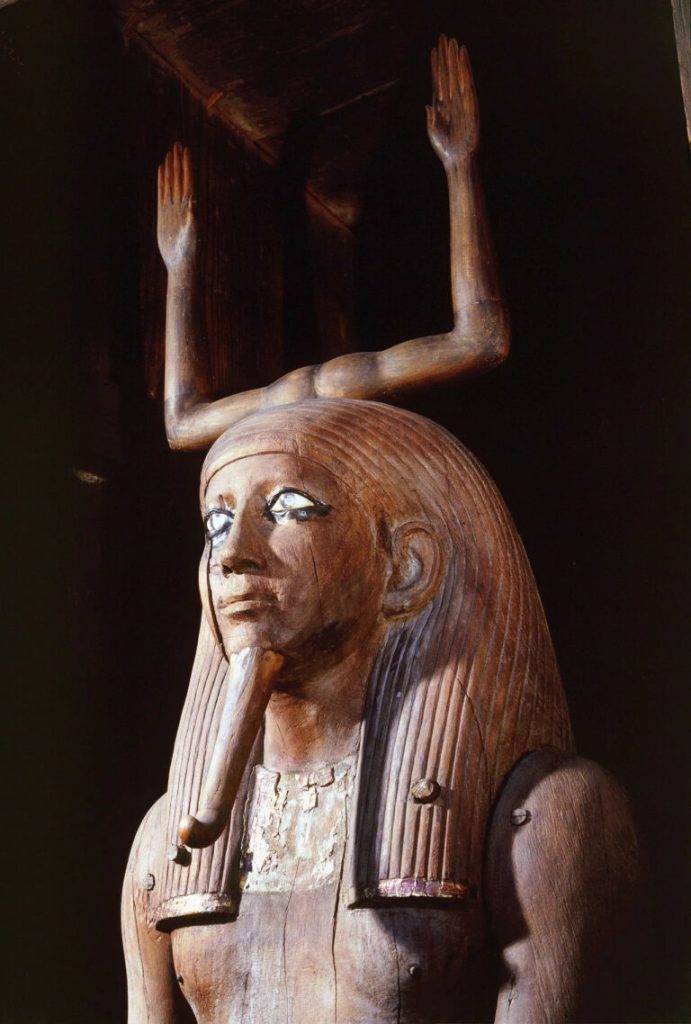In 1894, a team of excavators led by the renowned French archaeologist Jacques de Morgan made a discovery that would become one of the most significant finds in the study of ancient Egyptian spirituality and craftsmanship. While exploring the Pyramid Complex of Amenemhat III in Dahshur, Egypt, they unearthed an extraordinary artifact within the tomb of King Hor Awibre—also known as Hor I. This artifact, a finely crafted wooden Ka statue with stunning rock-crystal quartz eyes, has been preserved through the centuries as a powerful testament to both the beliefs and the artistry of ancient Egypt.

The Ka statue of King Hor I is far more than a beautiful relic; it embodies the spiritual philosophy and ritual practices that underpinned ancient Egyptian society. The concept of the “Ka” was central to Egyptian theology. It represented an individual’s life force or vital essence—an invisible double that accompanied a person throughout life and beyond death. According to belief, for the deceased to achieve eternal life, the Ka needed to be provided with sustenance and a physical representation, which was most often fulfilled by the creation of a statue. This is where the significance of the Ka statue lies—it served as the vessel through which the spirit could remain tethered to the earthly world.
Ka statues were meticulously carved, frequently from wood or stone, and painted to reflect the physical likeness of the deceased. They were not mere art objects; they were sacred conduits, believed to house the spirit of the individual and ensure their existence in the afterlife. The statue of King Hor I stands as a prime example of this belief in action. Measuring 135 centimeters in height (170 centimeters including the base and the Ka symbol), the statue is remarkably well-preserved considering its age. Its survival over thousands of years is a testament to the care and reverence with which it was created and maintained.
The craftsmanship evident in this statue is truly extraordinary. The figure of King Hor I is portrayed with intricate detail, wearing a three-part long wig, a style indicative of his royal status, which gracefully reveals his ears. The statue is also adorned with a long, curved divine beard—a symbol of divinity and kingship in ancient Egyptian iconography. While the paint has long since faded, traces on the wood suggest that the figure was once dressed in a ceremonial belt and kilt, enhancing its regal and dignified presence. The eyes, however, are what captivate most modern observers. Crafted from rock-crystal quartz, they give the statue a lifelike and almost ethereal gaze, drawing the viewer into an ancient world steeped in symbolism and reverence.
This statue was originally placed within a naos—a small shrine—that was partially adorned with gold foil and hieroglyphic inscriptions bearing King Hor’s royal titles. The naos would have been located in a mortuary chapel, a sacred space designed to house the Ka statue and serve as the focal point for rituals intended to sustain the deceased in the afterlife. These chapels were often elaborately decorated and inscribed, not only to honor the dead but to ensure the continuous interaction between the living and the spiritual realm. The placement of the Ka statue in such a context reveals how central these rituals were to Egyptian funerary practices and reflects the deep respect the Egyptians held for the afterlife.
The Ka statue of King Hor I exemplifies the ancient Egyptians’ belief in the interconnected aspects of a person’s existence—the physical body, the name, the ba (personality or soul), the šwt (shadow), and the Ka. Of these, the Ka was viewed as the most essential, the very essence of life that continued after death if properly cared for. The creation of a Ka statue ensured that the individual’s life force had a permanent and physical abode, allowing them to receive offerings and partake in rituals designed to sustain their existence for eternity.
Today, this magnificent Ka statue resides in the Egyptian Museum in Cairo, where it continues to captivate scholars and visitors alike. It stands not only as a work of remarkable artistic skill but as a powerful symbol of ancient Egypt’s profound spiritual beliefs and dedication to preserving life beyond death. Its presence allows modern audiences to peer into the past and appreciate the complexity of a civilization that devoted so much effort to understanding and honoring the mysteries of life and the afterlife.
The value of this artifact extends beyond its historical significance. It offers contemporary viewers insight into how the ancient Egyptians viewed existence, mortality, and eternity. It reflects the universal human desire to be remembered, to leave a mark on the world, and to connect with something greater than ourselves. Through this statue, we witness how art and spirituality intertwine to create a legacy that transcends time.
In reflecting on the Ka statue of King Hor I, we are reminded of the enduring ingenuity of ancient cultures and their quest to navigate the unknown with faith, creativity, and devotion. The statue is more than an object in a museum; it is a bridge to a time when the boundary between the physical and spiritual worlds was not only acknowledged but revered. It encourages us to consider our own beliefs about life and legacy, and to appreciate the ways in which history, art, and faith continue to shape the human experience.
This masterpiece, with its lifelike gaze and sacred purpose, remains a testament to the artistry and spiritual depth of ancient Egypt. Its discovery over a century ago continues to inspire wonder, respect, and a deeper appreciation for one of the world’s most fascinating civilizations. Through the preservation and study of such artifacts, we not only honor the past but enrich our understanding of what it means to be human.





